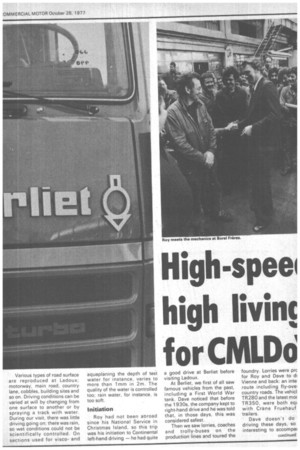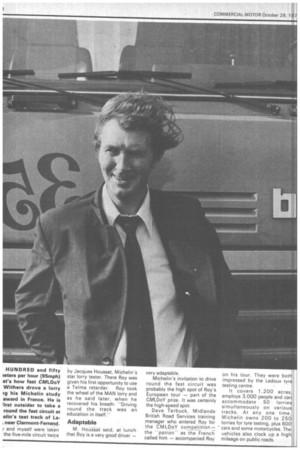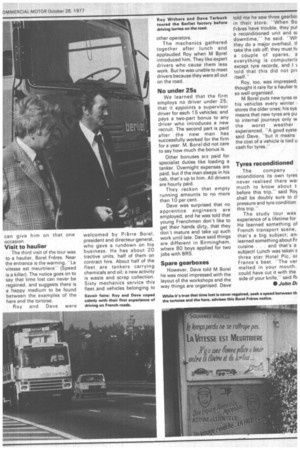High-spee high Iivinç for CIVILEki
Page 41

Page 40

Page 42

Page 43

If you've noticed an error in this article please click here to report it so we can fix it.
HUNDRED and fifty peters per hour (95mph) at's how fast CMLDoY Withers drove a lorry ig his Michelin study award in France. He is First outsider to take a round the fast circuit at elin's test track of La, near Clermont-Ferrand. / and myself were taken the five-mile circuit twice
by Jacques .Houssat, Michelin's star lorry tester. There Roy was given his first opportunity to use a Telma retarder. Roy took the wheel of the MAN lorry and as he said later, when he recovered his breath: "Driving round the track was an education in itself."
Adaptable
M. Houssat said, at lunch that Roy is a very good driver — very adaptable.
Michelin's invitation to drive round the fast circuit was probably the high spot of Roy's European tour — part of the CMLDoY prize. it was certainly the high-speed spot.
Dave Tarbuck, Midlands British Road Services training manager who entered Roy for the CMLDoY competitionthe "patron" as the French called him — accompanied Roy on his tour. They were both impressed by the Ladoux tyre testing centre.
It covers 1,200 acres, employs 3,000 people and can accommodate 50 lorries simultaneously on various tracks. At any one time, Michelin owns 200 to 250 lorries for tyre testing, plus 600' cars and some motorcycles. The vehicles also clock up a high mileage on public roads. Various types of road surface are reproduced at Ladoux; motorway, main road, country lane, cobbles, building sites and so on. Driving conditions can be varied at will by changing from one surface to another or by spraying a track with water. During our visit, there was little driving going on; there was rain, so wet conditions could not be scientifically controlled. On sections used for viscoand aquaplaning the depth of test water for instance, varies to more than lmm in 2m. The quality of the water is controlled too; rain water, for instance, is too soft.
Initiation
Roy had not been abroad since his National Service in Christmas Island, so this trip was his initiation to Continental left-hand driving — he had quite a good drive at Berliet before visiting Ladoux. At Berliet, we first of all saw famous vehicles from the past, including a First World War tank. Dave noticed that before the 1930s, the company kept to right-hand drive and he was told that, in those days, this was considered safest.
Then we saw lorries, coaches and trolly-buses on the production lines and toured the foundry. Lorries were prc for Roy and Dave to di Vienne and back: an inte route including fly-ovei country roads. The vehicl TR280 and the latest mot TR350, were both eqi with Crane Fruehauf trailers.
Dave doesn't do driving these days, so interesting to accompai on a 70km round trip in the 280. "At 38 tonnes gross, it has power to equal ours," he said. "In comfort, it's the last thing. I didn't have much trouble with the gearstick being on the wrong side, but! had to be very careful over width judgment."
Roy, after his first experience on a Continental road — at the wheel of the turbocharged V8 engined TR380 — told me: "I'm surprised there are not more Berliet's on British roads. These models will make their mark. The 380 has so much power.
Roy said that, at his BRS depot, the Ford Transcontinental — it has the same cab as the Berliet — is considered the greatest vehicle by drivers. But on the Ford, the cab is mounted independent to the chassis, so that it can lean on corners; and consequently it takes some getting used to. On the Berliets, the cab is fixed rigidly and he prefers this. They're beautiful vehicles," he said.
Much too close
His views on French traffic are interesting too. "I have always had the impression that Continental roads are all rush and bustle, but I never saw that once. Their motorway discipline is very good. They're not like English drivers, who keep one behind the other, much too close. In France you never get anyone coming up behind and flashing lights. And here, lorries can use the third lane," We also saw the Berliet computer at work on arithmetical simulation of road conditions. The system is called Simulation de Marche de Vehicle sur Route (SIMAVERO) When all the information concerning the vehicle and route to be taken is put into the computer, it works everything out, right down to the number of gearchanges necessary.
Well-skilled
Roy was also driven by car from Lyon to Valence-sur-Rhone and on toClermont-Ferrand; and he maintained his high opinion of French drivers. In Paris later, however, he experienced by taxi and car the tear and rush familiar on TV.
While at Berliet, the talk touched on what they think of foreign drivers, and we met M Rene Rolland, national presid-: ent of the French Association of Truck Drivers' Friends. "Spanish and Italian we don't mention," he said, "British drivers are well-skilled and compared to Germans and Hollandaise, the British are more gentlemanly."
So far, there has been much mention of speed and power; both from the aspect of safety, however. Berliet aims to give the driver performance in hand; at Michelin, they explain that they want their tyres to have the capability to withstand conditions which a driver may • meet only once in his lifetime. Because he will need all the adhesion and strength his tyres can give occasion. him on th at one
Visit to haulier
The third visit of the tour was to a haulier, Borel Freres. Near the entrance is the warning, ''La vitesse est meurtriere" (Speed is a killer). The notice goes on to say that time lost can never be regained, and suggests there is a happy medium to be found between the examples of the hare and the tortoise.
Roy and Dave were
welcomed by Pi 1-re Bore!, president and directeur-general, who gave a rundown on his business. He has about 20 tractive units, half of them on contract hire. About half of the fleet are tankers carrying chemicals and oil; a new activity is waste and scrap collection. Sixty mechanics service this fleet and vehicles belonging to
Savoir faire: Roy and Dave coped calmly with their first experience of driving on French roads. Roy Withers and Dave Tarbuck toured the Berliet factory before driving lorries on the road.
other operators.
The mechanics gathered together after lunch and applauded Roy when M Borel introduced him. They like expert drivers who cause them less work. But he was unable to meet drivers because they were all out on the road.
No under 25s We learned that the firm employs no driver under 25; that it appoints a supervisor driver for each 15 vehicles; and pays a two-part bonus to any driver who introduces a new recruit. The second part is paid after the new man has -successfully worked for the firm for a year. M. Borel did not care to say how much the bonus is.
Other bonuses are paid for specialist duties like loading a tanker. Overnight expenses are paid, but if the man sleeps in his cab, that's up to him. All drivers are hourly paid.
They reckon that empty running amounts to no more than 10 per cent.
Dave was surprised that no apprentice engineers are employed, and he was told that young Frenchmen don't like to get their hands dirty, that they don't mature and take up such work until late. Dave said things are different in Birmingham, where 80 boys applied for two jobs with BRS.
Spare gearboxes
However, Dave told M Borel he was most impressed with the layout of the workshops and the way things are organised. Dave'
told me he saw three gearbo in their store. "When Bc Freres have trouble, they pu a reconditioned unit and si downtime,he said. -Wi they do a major overhaul, ti take the cab off; they must Ft a couple of spares, E everything is computeriE except tyre records, and I told that this did not pr( itself,'"
Roy, too, was impressed; thought it rare for a haulier tc so well organised.
M Borel puts new tyres or his vehicles every winter stores the older ones; his sys means that new tyres are pu to internal journeys only w the worst weather experienced. "A good syster said Dave, "but it means the cost of a vehicle is tied u cash for tyres.
Tyres reconditioned
The company reconditions its own tyres never realised there wa! much to know about t.
before this trip," said Roy shall be doubly sure to cl pressure and tyre condition this trip.'' The study tour was experience of a lifetime for He learned something of French transport scene, that's a big subject; an learned something about Fr cuisine . . . and that's a subject! Lunch was taken a three star Hotel Pic, or France's best. "The ver melted in your mouth. could have cut it with the side of your knife," said IR( • John Di




















































































































